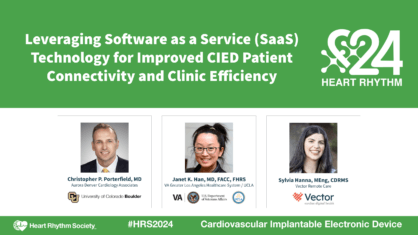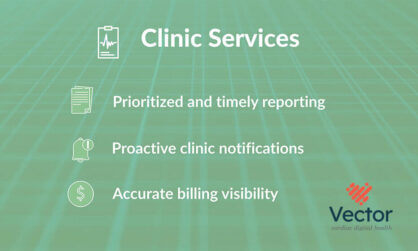Divide Remote Monitoring Duties to Deliver Better Cardiac Care

While there are many ways to improve Remote Cardiac Monitoring workflows, working with a third-party vendor is the easiest way to offload non-clinical tasks.
There was probably a time when your remote cardiac monitoring (RCM) program was small enough for one or two nurses to manage it all, but it’s unlikely that’s still the case. In many cardiology practices today, rapidly growing data, device, and reporting management responsibilities distract from patient care. These time-consuming tasks also make it difficult to keep patients connected and revenue flowing, much less grow the program. Given the benefits of RCM for patient care, that’s an unacceptable state of affairs.
Grasp the Problem
Vector’s recent survey of more than 110 U.S. cardiology practices exposed one of the most important barriers to fixing the workflow challenge: many physician practice leaders are not fully aware of the overwhelming burdens their staff face. The survey found that while 66% of staff respondents (Cardiac Device Techs, LPNs/RNs, and Medical Assistants) ranked reviewing alerts and keeping up with administrative work as their number one problem in maintaining their RCM, physicians did not cite this as a problem nearly as often.
Having practice leaders spend half a day in the device clinic is a first step in closing this critical communication gap. Those who have, attest to being surprised by how much time it takes to monitor data, respond to alerts, troubleshoot devices, call patients, follow up with providers by inputting reports into the EHR, and reconnect patients for routinely scheduled follow-ups. These technical and administrative burdens negatively affect care quality because skilled clinicians get bogged down in tasks that have little or nothing to do with their skill set. These burdens also contribute to high levels of staff turnover, hiring, and training. That’s when RCM enrollment numbers fall and some practices give up completely.
The survey also revealed that practices doing all the monitoring work themselves are struggling more than those working with a third-party vendor. This is hardly surprising. Typically, when a cardiology practice explores the use of a third-party vendor, it’s at a moment of crisis due to staffing turnover and poor systems that have failed to scale along with its patient population.
“Until I actually went down to our device clinic, I didn’t fully understand why, with so many people to administer our program, it was still inefficient. I didn’t see the nuances and how much work it really was. Vector made our RCM program into a much more efficient — and patient-centered — process.”
– Dr. Christopher Porterfield, Cardiac Electrophysiologist
RELATED REPORT: Struggling to Connect: 2021 State of Remote Cardiac Monitoring
Why Partnering With a Remote Cardiac Monitoring Expert Works
The benefits of working with an expert third-party vendor begin with offloading nonclinical tasks to a partner that will complete them more efficiently than most practices can. This frees your clinicians to focus on their patients, and your practice managers to focus on core business concerns, such as patient experience and billing.
Consider what this looks like in day-to-day operation:
- Automated Tasks: The best RCM vendors develop software that automates operational duties to optimize reimbursement and provide timely visibility into things like disconnected monitors and scheduling transmissions.
- Improved Patient Connections: Third-party partners recognize device connectivity problems and automatically generate messages to patients, prompting them to reconnect their device or schedule a call for additional support at their convenience.
- Live staff members may be immediately available to troubleshoot problems and educate patients and caregivers. This level of responsiveness also helps patients better comply with all aspects of their own cardiac care, deepening the connection between the patient and your practice.
- The Right People Doing the Right Tasks: Expert third-party vendors create workflows wherein highly trained people are dedicated entirely to the tasks they know best. For example, cardiac reporting experts review transmission summaries and alerts from monitors, ensuring those summaries meet each clinic’s requirements so providers receive clinically relevant information and avoid alert fatigue.
- Improved Clinical Collaboration: Top vendors help you manage patients across the healthcare continuum. Synthesizing data from multiple device portals, normalizing the data, and having it automatically flow into the EHR give clinicians access to all the data they need, in one place, to increase the time to treatment.
- Optimized Reimbursement: Vendors understand the ins and outs of submitting claims for RCM – and carefully track any procedural changes. This leads to increased enrollment and optimized claims submissions.
Divide and Conquer
Understanding the problem and developing workflows to address it – including ensuring your people are doing the work that best suits their skill sets – will significantly improve the care you deliver to your heart disease patients.
This divide and conquer approach is why Vector exists: to relieve administrative burdens, streamline your program, help you collect all appropriate revenue, and empower your skilled clinicians to do what they do best. The results are happier staff, improved on-time connection rates, enhanced revenue, and more satisfied, healthier patients.
For more information on the 2021 State of Remote Cardiac Monitoring, check out the full report.














